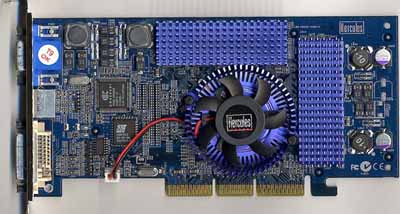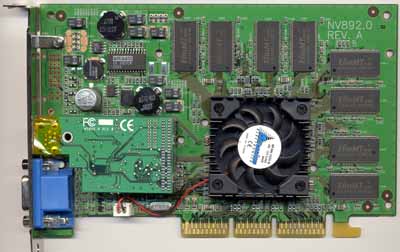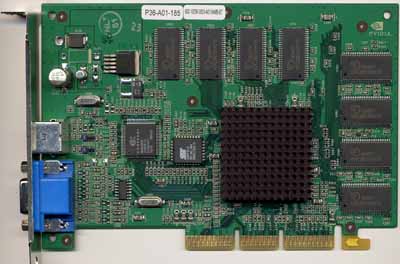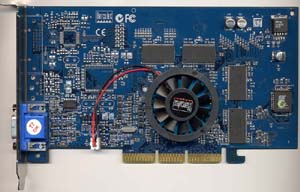
Original Link: https://www.anandtech.com/show/758
A Torrid Affair with Graphics: April 2001 3D Market Update
by Anand Lal Shimpi on April 23, 2001 12:00 PM EST- Posted in
- GPUs
In spite of the majority predicting a single sided race in the 3D graphics market because of the demise of 3dfx, quite the opposite is happening. It is quite clear that NVIDIA’s 6-month product cycles aren’t of much use at this point in time, as they are only competing against themselves at this point. The GeForce2 Ultra and soon the GeForce3 are the fastest overall 3D graphics accelerators on the market today, yet most consumers aren’t complaining about the performance of their hardware, rather they are looking for software to make use of that hardware.
Because of this, we are seeing a decreasing emphasis being placed on who can crank out cards the fastest and more of an emphasis on producing and releasing what makes the most sense. It was NVIDIA’s well-maintained 6-month product cycles that allowed them to drive competitors like 3dfx, Matrox and S3 out of the high-end market. However today, the rules have changed, it isn’t about driving competitors out of the market, but rather it is about driving technology. We have seen a similar effort in the CPU market, judging from what we saw at this year’s Spring IDF conference as well as the slowdown in processor releases. The major producing countries are feeling the effects of a slowing economy, but that does not necessarily mean that technology cannot continue to evolve and develop.
NVIDIA on the defense
As you have all probably seen by now, an internal sales document from NVIDIA was leaked to the public. This particular document was the propaganda equivalent of 101 reasons to not like ST Micro’s Kyro II part. From our recent review of the Kyro II you’ll realize that we positioned it not as a cost effective competitor to the GeForce2 MX, but rather an alternative to the more expensive GeForce2 Ultra or GeForce3. While the Kyro II clearly doesn’t boast the same feature set as the GeForce3, it is a good card to have in the interim between now and the point where DX8 titles start using the potential of the GeForce3 core.
On the sales side of things, NVIDIA views the Kyro II as a direct and obviously more attractive competitor to the GeForce2 MX. It was because of this threat to their previously untouched value line of cards that NVIDIA made the decision to put together this sales document. The majority of the document was intent on presenting the Kryo II as an unreliable, borderline dangerous solution for any of NVIDIA’s customers to offer. Unfortunately for NVIDIA, many of the arguments NVIDIA made in the document were grossly exaggerated. While the Kyro II does have its issues (we’ll get to those in a second), they are not nearly as devastating as NVIDIA had made them out to be. However we all know that NVIDIA is one of the most competitive companies in the sector currently, and we shouldn’t have expected any less of them, especially when threatened so quickly by nothing more than a value priced graphics accelerator from the creators of the Power VR.
The shock over the document in the community was expectedly great, but there is one thing that you have to take into account. Hundreds of similar documents have come and gone from other manufacturers in the industry, it’s a part of their marketing in such a highly competitive sector. Imagine the uproar that would be generated had the internal marketing documents of AMD, Intel or even 3dfx been revealed. While we all accused NVIDIA of taking statements about the Kyro II out of context (which they did), aren’t we partially guilty for taking NVIDIA’s marketing documents out of their context? We all know better than to believe the information that was presented as fact in the document, after all, it was a sales tool and how many of us really believe the sales pitches we’re given so often in our lives? Yet we were seemingly shocked to see it. This isn’t to justify it; it’s simply a different perspective. Just something to think about, I’m more than certain a lot of companies out there have some internal documents that would look utterly disgusting if they ever surfaced.
Quite possibly the best to come out of all of this was the fact that ST Micro did not respond to the document; a very mature move on their part. Unfortunately some harm may have come from the incident (I don’t believe for one minute that any of the recipients of the document blindly accepted it as fact) in that Guillemot, the parent company of Hercules, made some pretty bold statements about how threatened NVIDIA should feel by the Kyro II:
"They are right to be scared, 3D Prophet 4500 will really be a great product.” - Claude Guillemot, President, Hercules Technologies.
While we should all commend Mr. Guillemot for his statement, don’t expect Guillemot to exactly be on NVIDIA’s good side after this. NVIDIA is much like Intel was in 1998, with relatively low competition on a performance basis, and the ability to command quite a bit of power from those that depend on their chips. Let’s hope that Guillemot hasn’t burned any major bridges, but with them being the only ones pushing Kyro II so much now it’s difficult to see how they haven’t caused a little sizzle.
NVIDIA on the offense
In spite of the attractiveness of the Kyro II, it is still not a major threat to NVIDIA’s cash crop, the performance market segment currently dominated by the GeForce2 Ultra and soon enough, the GeForce3. However, NVIDIA has also taken a considerable amount of flak on the point that the GeForce3 is simply too expensive to justify its performance/features advantages over the GeForce2 line. The arguments are well founded, as a card retailing at between $500 - $600 whose power is being taken advantage of by a whopping zero game titles isn’t exactly what everyone wants to hear.
Fortunately, it seems like NVIDIA has been able reap the benefits of improved yields and a relatively quick ramp on GeForce3 core production at the Taiwan Semiconductor Manufacturing Company (TSMC), the fab for NVIDIA’s graphics chip production. Because of this, the GeForce3 will now carry a price tag of $399 making it much more reasonable than the $500 - $600 estimates we were originally given although still leaning towards the expensive side.
At $399, the GeForce3 is contributing less than 1/3 the overall cost of building an high performing $1500 system, and considering the extreme cost cutting measures we’ve seen in the CPU market, putting together a fast $1500 system with a GeForce3 shouldn’t be too far of a stretch without having to skimp on too many components.
Unfortunately NVIDIA’s price drop can only make the purchase easier to swallow, it cannot however, cover up the fact that there are simply no titles that take advantage of the GeForce3’s incredible technology. While you can make the argument that the GeForce3 offers better memory bandwidth utilization and more flexibility from an Anti-Aliasing standpoint, whether or not that justifies the $400 price tag is still a shady answer. That answer obviously lies in your hand, and for many more now that the price has dropped, the answer may end up being yes. A 32MB GeForce3 might be able to push prices even further, but NVIDIA really has no reason to release an even "cheaper" GeForce3 since it has no other DX8 parts to compete against.
We’re going to have to stick to our guns on this one and still recommend that if you can wait, hold off until games actually require the features behind the GeForce3 before plunking down your cash for one. If you want something to tide you over until then, NVIDIA has a few attractive options, as does ST Micro. If, however, you must upgrade now and won’t upgrade again for quite a while (read: over 9 – 12 months), then the GeForce3 may be an investment worth looking at.
NVIDIA's Spring Line
Yesterday, NVIDIA announced their “Spring line” of graphics accelerators. Before you get excited, the line is nothing new, in fact one member of the line is something we reviewed at the end of last year. For starters, NVIDIA is bringing the GeForce2 Pro to market as a retail card and not only as an OEM solution. If you’ll remember back to our review of the GeForce2 Pro from last December, we thought it was a great alternative to the GeForce2 Ultra since it was noticeably cheaper and offered a good deal of the performance.
NVIDIA's GeForce2 Pro Reference Board
The reason that the GeForce2 Pro is cheaper than the Ultra is because of the fact that it runs at the same core clock speed as the regular GeForce2, 200MHz. The Ultra however, is a lower yield part that operates at 250MHz. The high-frequency, low yield chips like the GeForce2 Ultra are often much more expensive to produce (since much fewer actually work at this higher frequency) and thus increase the overall cost of the boards. The GeForce2 Pro does have a lower memory clock than the Ultra (200MHz DDR vs 230MHz DDR), but it is priced at around $100 less than the Ultra according to our latest Weekly Video Card Price Guide. NVIDIA’s official price on the GeForce2 Pro will be $229. It seems like NVIDIA is attempting to de-emphasize the role of the GeForce2 Ultra in their product line which makes sense, since it is much cheaper for NVIDIA to sell GeForce2 Pros that it is for them to move Ultras.
NVIDIA's GeForce2 MX 400 Reference Board
The second release NVIDIA made yesterday was the GeForce2 MX 400. This part is one we also recently reviewed and as you will remember from that review, the performance is indiscernible from the regular GeForce2 MX. The only real difference is a 200MHz core clock (which makes sense since Geforce2s currently ship at 200MHz and the MX yields were close to that good when it was released) and 64MB configurations. The latter doesn’t really help performance too much however it may down the road when texture sizes grow even further.
One month until Kryo II
Without a doubt, ST Micro’s Kyro II has become the hit that the original Kryo never seemed to excel to be. Even more interesting is the fact that the chip is still a month away from release yet it has attained this level of stardom very quickly, can you see why NVIDIA felt defensive?
As I mentioned at the start of this editorial, the Kyro II isn’t without its problems. We have been working closely with Hercules to get the latest driver set and board revision of their Kyro II based 3D Prophet 4500 unfortunately we haven’t seen anything since our original review of the card. We are holding off on a follow-up until we get a final board as well as final drivers since there are a number of issues with the current hardware.
For starters, compatibility with i815 platforms seems to be relatively poor with the board we have as well as boards that have been sent to other reviewers. We would experience 2D artifacts and random lockups on our i815 test beds, regardless of the motherboard used. Even using Intel’s own i815 board did not solve the problems, although we did not experience any of these on our Athlon test bed. It was a bit of a shock to see this, especially after remembering the days when AGP cards would have compatibility problems with AMD systems yet worked perfectly with Intel systems. How times have changed, luckily it only seems prevalent with the pre-release Hercules 3D Prophet 4500 that we have in lab. Hercules has assured us that they are working on fixes for these problems, although until we see a final board we’re going to hold off on accepting that statement just yet.
Hopefully Hercules under the management of Guillemot will have more sense about releasing products that aren’t ready for prime time than the original Hercules corporation did when they released their Terminator BEAST card over two years ago.
On the driver side of things, apparently quite a bit of progress has been made internally. Mercedes Benz Truck Racing is now working properly, which is more than can be said about the title on the GeForce3’s current drivers. There has also apparently been a number of fixes under titles such as the Aquanox test that we used in our GeForce3 Review.
Overall we are still very impressed with the Kyro II, however after play testing it for days on end there are still a significant amount of driver issues (at least with the driver build used in our review) that would prevent us from flat out recommending the card with the utmost confidence in it. Hercules has a month to change our minds, let’s see what happens as they have stated the card will hit the streets on May 16th.
ATI: Stuck between a rock and a hard place
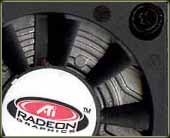 In
spite of the title of this section, ATI is doing quite well. The problem they
are having is that, from a marketing standpoint, they cannot claim that they
have a fully functional DX8 part on the market like NVIDIA can. While we all
know that this means very little since there are no titles that take advantage
of the technology, it is still a feather missing from ATI’s cap. And as you
have undoubtedly heard, the R200 or successor to the Radeon, will not be released
until the fourth quarter of this year. We actually commend ATI on this decision
since the theory behind it is that by that time there will hopefully be titles
available that can actually use the hardware. However in order to show the
world that they are still in the game they will be doing a technology announcement,
much like they did with the original Radeon,
in the next month or so.
In
spite of the title of this section, ATI is doing quite well. The problem they
are having is that, from a marketing standpoint, they cannot claim that they
have a fully functional DX8 part on the market like NVIDIA can. While we all
know that this means very little since there are no titles that take advantage
of the technology, it is still a feather missing from ATI’s cap. And as you
have undoubtedly heard, the R200 or successor to the Radeon, will not be released
until the fourth quarter of this year. We actually commend ATI on this decision
since the theory behind it is that by that time there will hopefully be titles
available that can actually use the hardware. However in order to show the
world that they are still in the game they will be doing a technology announcement,
much like they did with the original Radeon,
in the next month or so.
Another project that ATI has been working on is a response to the GeForce2 Ultra, a 64MB Radeon DDR running at a 250MHz core clock with a 250MHz DDR memory clock. We actually first found out about this card months ago when ATI accidentally used this 250/250MHz card in some benchmarks they sent us. We have seen pictures of this card, sometimes referred to as the Radeon SE, appear on the web already. It is still unclear if ATI will go ahead with this card, however if they do, it will definitely be very aggressively priced.
Matrox: No G800
In closing we’ll leave you with a bit of news that may be sad to hear for Matrox fans. The G800 everyone has been waiting for is officially not going to be released. This was actually what we hinted at the last time we talked about Matrox, unfortunately back then we weren’t able to come out and say it for sure.
Matrox is continuing their stance that they will re-enter the gaming market at one point, but don’t expect that to be with their next card. I know that there are rumors flying around about chip names found in Matrox drivers, but don’t set yourself up for a disappointment. Matrox won’t be focusing on the gaming market anytime in the near future.
Final Words
I hope you enjoyed this little article, thanks for the support you’ve given me and the rest of the AnandTech family over the past four years. We have quite a few surprises for you this year, and I will make sure personally that we do whatever it takes to continue to make AnandTech the best it has ever been.
-- Anand Lal Shimpi

